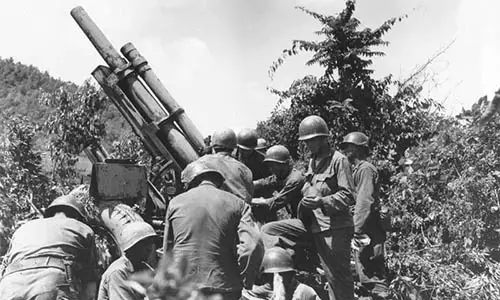1. The historical events leading to the outbreak of the Korean War started in 1895, when Japan took control of Korea. In 1910, Korea was made a part of Japan. In 1945, Japan was defeated in World War II. Soviet and US forces moved into Korea, dividing the areas of control according to the latitude 38 degrees North, or the 38th parallel. The area south of the 38th parallel was occupied by the Americans. When the United Nations (UN) called for the unification of Korea and elections for a single government, the Soviet Union objected. This led to the formation of North and South Korea as separate countries. Both sides laid claim to the whole country, and there were many military skirmishes between 1948 and 1950. As South Korea had elected its own government in 1948, USA removed all its troops in 1949.
2. The Korean War took place from June 25th, 1950 to July 27th, 1953. The immediate cause of the war was the invasion of South Korea by North Korea. As North Korea was a Communist country, it was helped by China and the Soviet Union.
3. The UN had been established just five years before, and the Korean War was its first major challenge as a global peacekeeper. The UN declared the invasion a violation and asked North Korea to withdraw its troops, but hostilities did not cease. The US President Harry Truman mobilised American air and naval units, and the UN called upon its members to provide help to South Korea.
4. On June 30th, 1950, President Truman deployed ground forces in South Korea. Army units from other UN members kept joining the Americans. The UN Security Council approved the appointment of General Douglas MacArthur as Commander-in-Chief of the Allied forces. Tokyo was the headquarters of the Allied operations. The head of the US Eighth Army, Lieutenant General Walker was named field commander in Korea.
5. Between June and September 1950, the North Korean forces took over most of Korea. The Allies held only the southeast corner of South Korea. The battle line was called the Pusan Perimeter. The Allies were able to repel Communist advances by holding firm at the Pusan Perimeter, and inflicting losses of enemy soldiers and equipment. US jets provided air support.
6. In September, 1950, the US X (Tenth) Corps made a surprise landing at Inchon on the northwest coast. The X Corps captured Seoul, while the forces at the Pusan Perimeter moved forward to join up with the X Corps. General MacArthur tried to get North Korea to surrender, but they refused.
7. South Korean troops crossed into North Korea in October and captured Pyongyang. The Allied forces moved towards the border that North Korea shared with China. The Chinese then engaged in battle with them till November, when they suddenly pulled back. General MacArthur ex pected the war to end by Christmas, but on November 26th and 27th, the Chinese launched a massive offensive and the Allies were forced to retreat. To make matters worse, General Walker died in a jeep accident. The Communist forces regained Seoul in January, 1951. Lieutenant General Ridgway took over from General Walker, and the Allied forces slowly started advancing towards Seoul. They regained control of Seoul without fighting, in March. From this time onwards, neither advanced, but battles were fought along a line roughly to the north of the 38th parallel.
8. In April, 1951 General MacArthur was relieved of his command by President Truman. The General was advocating a policy of full-scale aggression while Truman was wary of starting another World War. Ridgway took MacArthur’s place in Tokyo, and Lieutenant General Van Fleet was appointed as commander of the Eighth Army in Korea. By July of that year, talks regarding a truce began. In November, both sides agreed that the existing battle line would serve as a border between North and South Korea. In April, 1952, the Communists rejected a call for the voluntary repatriation of prisoners, and by October peace talks came to a halt. Then in March, 1953, the Communists agreed to exchange prisoners who were sick or wounded. The peace talks resumed shortly after this, and on July 27th, 1953, the war finally ended with the signing of an armistice.
9. The Korean War was the first instance in which the UN sent armed forces to a country. It was also the first time that jets were used in combat. The US Air Force’s F- 86 jets helped the forces on the ground. The Russian MiG 15s were used by Chinese and North Korean pilots in retaliation. The US Navy also played an important role in the war, providing support for coastal landings and destroying torpedo boats.
10. The Korean War did not last long but its effects were devastating. It is estimated that about 5 million people were killed altogether, many of them civilians. Most parts of Korea were badly damaged, and both the north and south needed extensive re-construction. The border decided on at the end of the war, is still maintained, and there is no hope of unification in the near future.









Leave a Reply